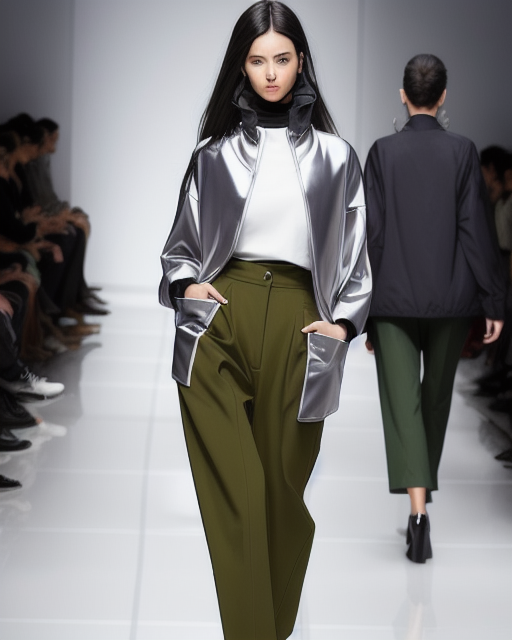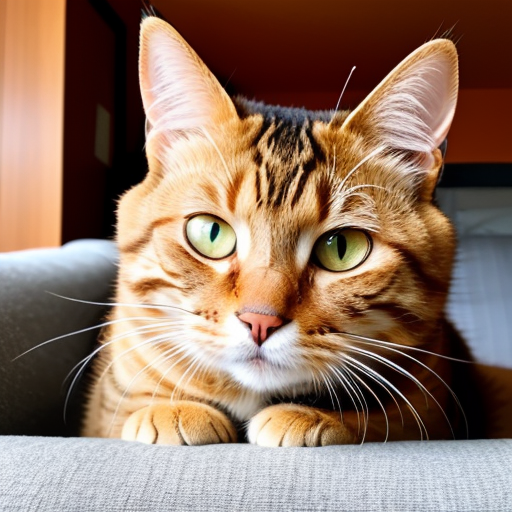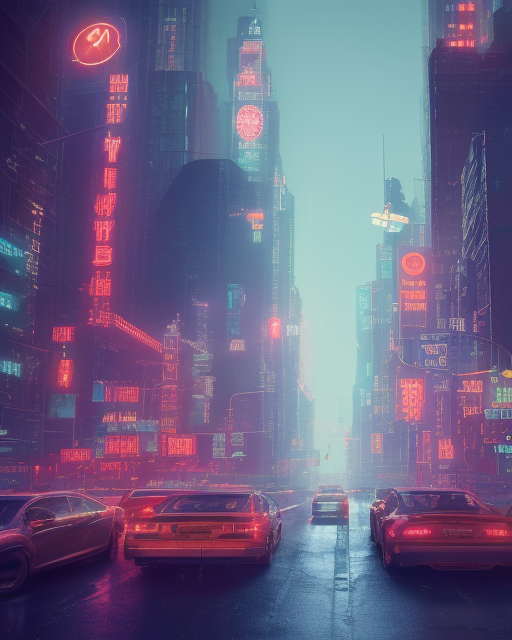The Help That AI Can Give
In the ever-evolving world of fashion, technology is constantly making an impact. With the advancements in Artificial Intelligence (AI), the fashion industry has seen a new level of creativity and innovation. One of the latest breakthroughs is the IMG Converter AI, which is designed to generate high-quality images of clothing items. This technology is continually improving, and users have noticed significant enhancements in the realism and uniqueness of the images produced.
IMG Converter AI has been widely adopted in the fashion industry as it saves time and effort while producing high-quality images. With the AI’s ability to understand and process visual data, designers and fashion enthusiasts can now produce stunning images of clothing items without the need for expensive photoshoots. Furthermore, the AI-generated images can be easily tweaked, modified and enhanced to fit the designer’s vision, ensuring a unique and personalized final product.
The potential of AI-generated images is vast, and it has created endless possibilities in the fashion industry. As fashion continues to evolve, the use of AI will become more widespread and prominent, and the IMG Converter AI is just the beginning of what is possible. In this article, we’ll take a closer look at how this technology can benefit designers and fashion enthusiasts, and how it is transforming the way we create and consume fashion imagery.
Modern Fashion Industry
The fashion industry is constantly evolving, and one of the most significant changes we have seen recently is its shift towards inclusivity and accessibility. Fashion brands are becoming more transparent with their practices and are actively engaging with consumers to create collections that cater to diverse body types, skin tones, and personal styles. This increased openness has led to a surge of interest in fashion among the general public, fueled by high-profile events such as the Met Gala, which showcase the latest trends and designs.
Current trends in the fashion world are leaning towards bolder colors and styles, with designers experimenting with unconventional combinations and blending them with classic pieces. This shift towards more daring and unique fashion styles has presented challenges for designers, who must constantly come up with fresh and innovative ideas to stay relevant. This is where artificial intelligence (AI) can play a vital role in the fashion industry.
AI can be used for image generation, a process that involves training a machine learning model on a dataset of images to generate new images that are similar in style and composition. This technology can be particularly helpful in creating fashion designs that are bold and unique, as AI models can generate a vast number of designs and combinations that may not have been possible for designers to create on their own.
Moreover, AI can help fashion brands to streamline their design process and reduce the time and resources needed to create new collections. By using AI to generate designs and prototypes, designers can focus on refining and perfecting the final product, ensuring that it meets the needs and preferences of their customers.
AI has all the potential to play an increasingly important role in driving innovation and creativity. As fashion becomes more accessible and inclusive, people are looking for fresh and unique ideas, and AI-generated images can provide that much-needed inspiration. The possibilities are endless, and as technology continues to advance, we can only expect AI to become an even more integral part of the fashion industry.
Inspiration From Good Old Days
The fashion industry has always been at the forefront of embracing new technologies to enhance the design process. One such technology that has gained significant traction in recent years is AI-powered image generation. With AI, designers can create a virtually endless variety of clothing designs and styles, providing an exciting opportunity to explore uncharted territories in fashion.
AI technology is based on self-learning from already existing photos, images, and artwork. This means that designers can specify specific examples that the AI image generation tool should reference when creating clothing. For example, if a designer wants to create a dress with a specific pattern, they can feed the AI tool images of similar patterns to use as a reference. This process is much faster and more efficient than trying to create designs manually.
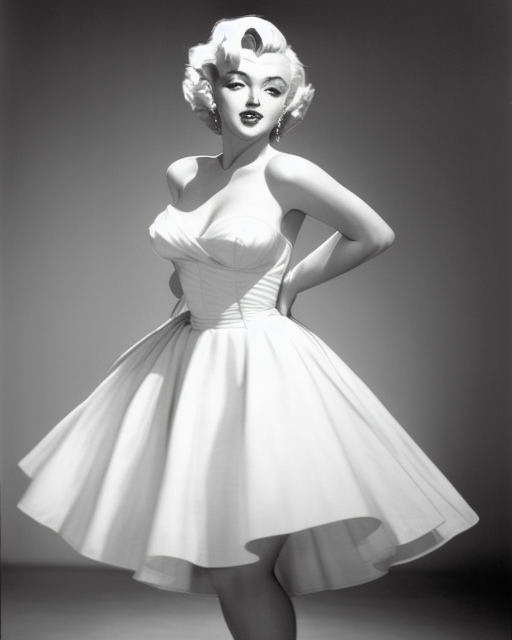
An AI-generated dress inspired by one of Marilyn Monroe’s famous outfits
Moreover, AI-powered image generation can provide designers with unexpected options they might not have thought of. Not everyone has the amount of information a neural network is capable of storing in their memory. Thus, AI algorithms can generate unique designs based on large amounts of data that designers might not have access to.
AI can also analyze vast amounts of data, such as customer preferences, purchase histories, and social media interactions to create designs that are most likely to be popular among consumers. This data-driven approach can save designers time and effort by eliminating guesswork and ensuring that their creations are in line with market demand.
Reasons To Refer to the Greatest
The fashion industry has always been at the forefront of innovation, with designers constantly pushing the boundaries of creativity and technology. With the rise of artificial intelligence (AI), fashion designers have found new ways to create unique and stunning designs that capture the imagination of audiences. In this article, we will explore how AI can be used to generate images for the fashion industry and why it is essential to refer to the works of famous designers and fashion houses when creating these images.
One of the primary benefits of using AI to generate images for the fashion industry is the ability to create unique designs quickly. With the help of AI, designers can generate a vast range of designs and variations in a matter of seconds, freeing up time to focus on other aspects of the design process. However, to ensure that these designs are relevant and appealing to the target audience, it is crucial to refer to the works of famous designers and fashion houses.
By studying the works of famous designers and fashion houses, designers can gain insight into what makes a design successful in the fashion industry. They can analyze the colors, patterns, textures, and materials used in these designs to determine what works and what does not. By doing so, designers can create new designs that are not only visually appealing but also resonate with their target audience.
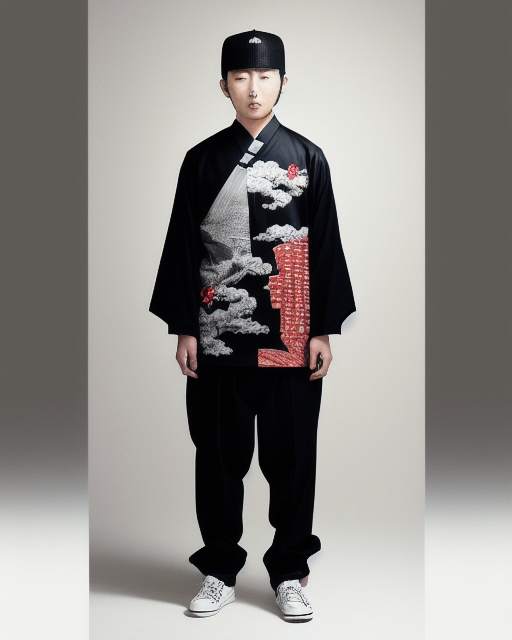
AI-generated design of men’s attire inspired by combining elements of Eastern culture and street style
Another benefit of referring to the works of famous designers and fashion houses when generating images is the ability to stay on-trend. Fashion is an ever-changing industry, and staying up-to-date with the latest trends is essential to remain relevant. By studying the works of famous designers and fashion houses, designers can identify emerging trends and incorporate them into their designs. This ensures that the designs they create using AI are not only visually appealing but also align with current fashion trends.
Moreover, by referring to the works of famous designers and fashion houses, designers can avoid inadvertently copying existing designs. The fashion industry is highly competitive, and designers must be careful not to infringe on the intellectual property of other designers. By studying the works of famous designers and fashion houses, designers can ensure that their designs are unique and original, avoiding any legal issues that may arise.
To sum up, the use of AI to generate images for the fashion industry offers numerous benefits, including the ability to create unique designs quickly. However, it is essential to refer to the works of famous designers and fashion houses when generating these images. By doing so, designers can gain insight into what makes a design successful, stay on-trend, and avoid copying existing designs. With the right approach, AI can be a powerful tool for fashion designers, helping them create stunning designs that capture the imagination of their audience.
Uniqueness of AI-Generated Designs
The fashion industry is known for its creativity, and designers are always looking for new ways to create unique and stunning designs that capture the imagination of their audience. With the help of AI, designers can now turn their wildest ideas into reality in a matter of minutes. AI is not limited by prejudices and emotions, allowing it to generate ideas that may seem crazy or unconventional to human designers.
One way that AI can help designers realize even the craziest ideas is by combining styles that are not commonly combined. For example, AI can generate designs that combine elements of traditional Japanese clothing with modern streetwear. This can result in designs that are both unique and visually striking, capturing the attention of the audience.
Another example of how AI can combine styles is by blending vintage and futuristic styles. AI can generate designs that incorporate elements of vintage clothing, such as high-waisted pants or oversized jackets, with futuristic elements such as metallic fabrics or geometric patterns. This combination creates a visually stunning and unique design that is sure to turn heads.
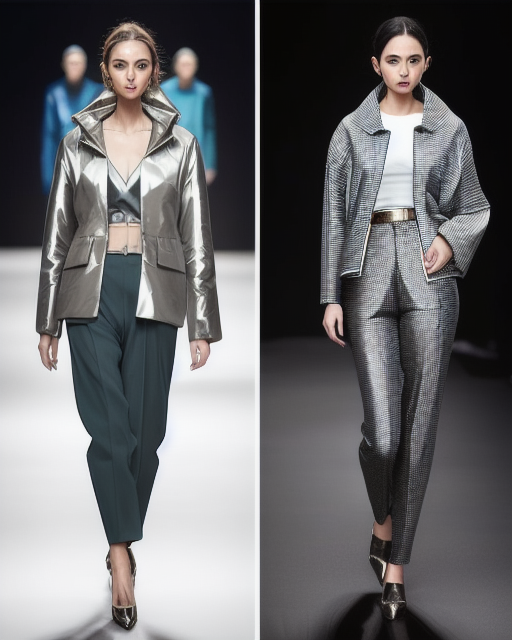
AI-generated examples of women’s modern clothing with elements of futurism and classics
In addition to combining styles, AI can also generate designs that incorporate unconventional materials. For example, AI can generate designs that use recycled materials, such as plastic bottles or old clothing, to create sustainable and environmentally-friendly designs. This can result in designs that are not only visually appealing but also socially responsible.
One of the most significant advantages of using AI to generate these unique and unconventional designs is the speed at which it can produce them. In a matter of minutes, AI can generate thousands of designs, providing designers with a vast range of options to choose from. This allows designers to focus on selecting the best design that resonates with their target audience, rather than spending countless hours trying to come up with new ideas.
By breaking free of prejudices and emotions, AI can generate ideas that human designers may not have thought of, providing a vast range of options in a matter of minutes. With the help of AI, designers can push the boundaries of creativity, creating unique and stunning designs that capture the imagination of their audience.
Other Areas For Clothes
In today’s world, clothes are not just a necessity but also an expression of one’s personality and style. The fashion industry has always been a crucial aspect of our lives, and the use of artificial intelligence (AI) in this field has been gaining popularity in recent years. AI has proved to be a game-changer in the fashion industry, especially in image generation, where it can help create stunning designs and concepts.
The use of AI in the fashion industry has revolutionized the way clothing designs are created. With the help of AI, designers can generate unique and innovative patterns, designs, and even entire clothing lines. AI has enabled fashion designers to create custom designs, textures, and color combinations, which were previously impossible to create manually. Furthermore, AI has helped fashion designers save time and effort, allowing them to focus more on creativity and design innovation.
One of the most exciting applications of AI in the fashion industry is the creation of digital clothing. With the rise of virtual reality and augmented reality technologies, digital clothing has become a hot topic in the fashion industry. AI algorithms can generate stunning digital clothing designs that can be used in virtual try-on applications or even in video games, movies, and TV shows.
AI can also be used to create stunning concept art for fashion designers. Concept art is an essential part of the fashion design process as it helps designers visualize their ideas and bring them to life. With AI, designers can create stunning concept art that can be used as a reference for the final design. This not only saves time but also helps designers experiment with different styles and ideas.
AI can also be used to generate clothing designs that cater to specific demographics or occasions. For example, AI algorithms can generate clothing designs that are perfect for a particular age group, body type, or even cultural background. Additionally, AI can create designs that are perfect for different occasions like weddings, formal events, or even everyday wear.
The use of AI in the fashion industry has also opened up new avenues for fashion enthusiasts and hobbyists. With the help of AI, anyone can create stunning clothing designs, regardless of their skill level. There are many AI-powered fashion design tools available online that allow users to create custom clothing designs with ease. These tools also provide suggestions and recommendations based on the user’s preferences and style.
Top-5 Fields in need of clothes
The fashion industry is not limited to traditional clothing and accessories. In fact, fashion concepts play a significant role in various areas, including games, comics, and more. The use of AI in generating clothing concepts for these areas has opened up new possibilities and opportunities for designers and enthusiasts alike. Here are five areas where clothing concepts generated by AI may be useful:
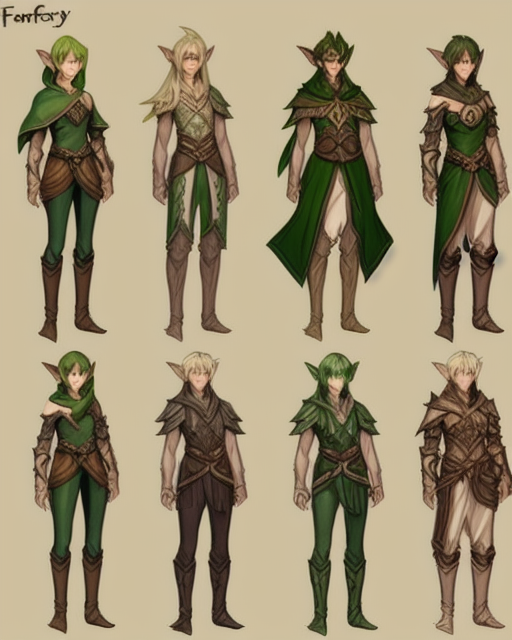
AI-generated concept art of forest elf clothing for a video game
- Video Games – Clothing concepts in video games have become increasingly popular over the years. From armor and weapons to various accessories, the fashion aspect of video games is critical in enhancing the player’s overall experience. In games such as RPGs, clothing designs are often categorized based on classes such as warriors, mages, and archers. Therefore, AI-generated clothing concepts can cater to specific classes, offering unique designs that complement the game’s narrative. Popular styles in this area include fantasy, futuristic, and post-apocalyptic designs.
- Comics and Graphic Novels – Clothing designs in comics and graphic novels play a vital role in character development and storylines. AI-generated clothing concepts can create designs that align with the character’s personality, backstory, and overall aesthetic. In superhero comics, for example, the clothing designs must match the character’s abilities and powers. Moreover, AI-generated clothing concepts can help create unique costumes for cosplayers and enthusiasts. Popular styles in this area include superhero, gothic, and steampunk designs.
- Animation – Clothing designs in animation are essential in creating memorable characters and settings. From Disney to Anime, clothing designs are a crucial aspect of character design and animation. With AI-generated clothing concepts, designers can create unique outfits that match the character’s personality, setting, and story. Moreover, AI-generated clothing concepts can help create costumes for cosplay and fan art. Popular styles in this area include anime, Disney, and retro designs.
- Advertising and Marketing – Clothing designs play a crucial role in advertising and marketing campaigns. Whether it’s a fashion brand or a product, clothing concepts can create a lasting impression on consumers. With AI-generated clothing concepts, designers can create unique designs that resonate with the target audience. Moreover, AI-generated clothing concepts can help create campaigns that align with the latest fashion trends. Popular styles in this area include modern, minimalist, and retro designs.
- Movies and TV Shows – Clothing designs in movies and TV shows are essential in creating memorable characters and settings. From period dramas to science fiction, clothing designs play a crucial role in the narrative and aesthetics of the production. With AI-generated clothing concepts, designers can create unique outfits that match the era, setting, and narrative of the production. Moreover, AI-generated clothing concepts can help create costumes for cosplayers and enthusiasts. Popular styles in this area include vintage, period, and science fiction designs.
The styles in demand in these areas are diverse, from fantasy and futuristic designs to minimalist and period styles. As AI technology continues to evolve, we can expect more groundbreaking applications in the fashion industry for these areas in the future.
Capabilities of AI in Design Making
With the use of AI-powered image generation tools such as the IMG Converter, designers can now concentrate on creating an image as a whole or focus on individual elements of the image. This allows for greater flexibility in the design process, allowing designers to create unique and innovative designs quickly and efficiently. Here are some examples of how the IMG Converter can be used to generate individual elements for different fashion items:
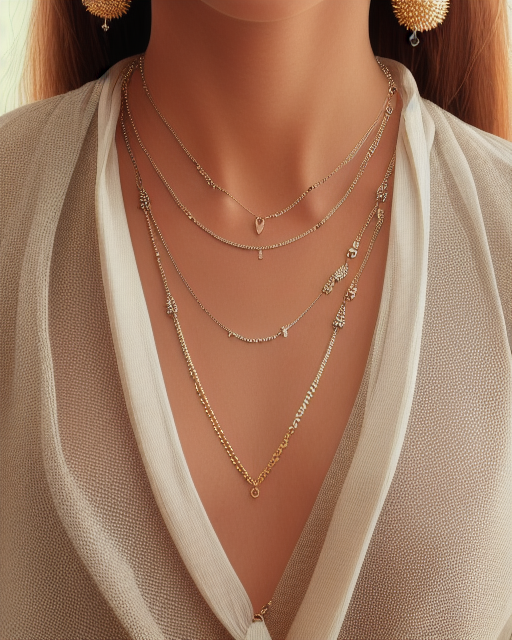
Example of AI generated jewelry made of different alloys
- Jewelry – With the IMG Converter, designers can create individual jewelry pieces, such as necklaces, earrings, and bracelets. The AI-powered tool allows for unique and intricate designs to be generated quickly and efficiently. Designers can experiment with different materials, shapes, and sizes, creating one-of-a-kind jewelry pieces that will surely catch the eye.
- Bags – The IMG Converter can also be used to create individual elements for bags such as handles, clasps, and straps. Designers can experiment with different materials, patterns, and shapes, creating unique and stylish bags that are not only functional but also aesthetically pleasing.
- Shoes – With the IMG Converter, designers can create individual shoe elements such as soles, laces, and buckles. The tool allows for designers to experiment with different materials, colors, and textures, creating unique and innovative shoe designs that are not only stylish but also comfortable.
- Outerwear – The IMG Converter can be used to create individual elements for outerwear such as buttons, zippers, and hoods. Designers can experiment with different materials, patterns, and colors, creating unique and stylish outerwear that not only looks good but also keeps the wearer warm and comfortable.
- Dresses – With the IMG Converter, designers can create individual dress elements such as sleeves, collars, and hemlines. The tool allows for designers to experiment with different materials, patterns, and shapes, creating unique and innovative dress designs that are both stylish and comfortable.
- Men’s Clothing – The IMG Converter can be used to create individual elements for men’s clothing such as buttons, pockets, and collars. Designers can experiment with different materials, patterns, and colors, creating unique and stylish men’s clothing that not only looks good but also fits well.
- Women’s Clothing – The IMG Converter can also be used to create individual elements for women’s clothing such as buttons, zippers, and sleeves. Designers can experiment with different materials, patterns, and shapes, creating unique and innovative women’s clothing designs that are both stylish and comfortable.
In conclusion, the IMG Converter allows designers to create individual elements for different fashion items, enabling them to experiment with different materials, patterns, and shapes, resulting in unique and innovative designs. With its AI-powered capabilities, designers can create stylish and functional designs quickly and efficiently, making the design process more accessible and enjoyable. As the technology continues to evolve, we can expect more groundbreaking applications in the fashion industry, helping designers unleash their creativity and imagination.
